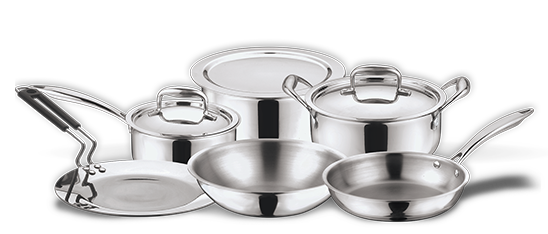What is tri-ply cookware? 5-ply cookware? Even 7-ply cookware? This is one of the frequently asked questions we receive at MetroKitchen. If you are in the market for some new 3-ply cookware or 5-ply cookware, you are probably going to do some research to decide which is the right type of ply cookware for you. Here is some great information to help you in your quest to find out the difference between tri-ply (or 3-ply) and 5-ply, and other ply cookware available in today’s marketplace.
Ply cookware refers to the layers of metals used in the construction of the bottom of the pot or pan, and sometimes the entire vessel. Each metal “ply” has its own purpose in the construction of the cookware. When you sandwich different “ply of metal” together to form a pot or pan, you are able to utilize the best properties each metal has to offer. The more layers of metals in the cookware, the thicker the pot or pan is, and therefore sometimes the more expensive the price of the cookware tends to be.
Tri-ply Cookware
Three ply cookware is three different layers of metal bonded together, most often stainless steel and either aluminum or copper. Some cookware is constructed an with aluminum base or disc. Other cookware brands, such as All-Clad cookware offer aluminum up the sides of the cookware as well. All-Clad stainless cookware is the most popular type of tri-ply cookware amongst chefs and consumers around the globe. Made in the USA, All-Clad stainless cookware uses a tri-ply bond construction which incorporates 18/10 stainless steel, aluminum, and magnetic stainless steel. Stainless cookware is used for its durability, and ease of maintaining and cleaning the pan. The aluminum center core, clad with stainless steel ensures your food will cook evenly. The magnetic stainless steel exterior enables the cookware to be induction compatible, and perfect for use on all other heating sources available in kitchens today.
You will find many different brands that carry tri-ply cookware. This type of ply cookware is especially popular, consisting of stainless steel bonded to an aluminum core (similar to All-Clad), but then an anodizing process is applied to the exterior to create a third layer. This third layer of hard anodized aluminum is great for all around heat conduction and durability. This means your food will cook evenly, leaving little or no hot spots.
Recently there has been an increase in the number of layers or ply added to the cookware. Many companies now feature cookware that has 5-ply or even 7-ply construction.
5-ply Cookware
5-ply means that cookware is constructed with 5 layers of metals. There are not many additional benefits of 5-ply versus the 3-ply. Some experts say that due to the thickness of the 5-ply cookware, it reduces the chances of warping over a long period of time. Sometimes the weight of a 5-ply pan can be heavier than a 3-ply pan, due to the extra layers. Usually more expensive than the 3-ply, several brands have introduced 5-ply cookware, including All-Clad. Mauviel, a French cookware company, has a 5-ply stainless steel cookware line. According to Mauviel, the 5-ply stainless enables fast even heat distribution for superior cooking. Usually the added metals consist of aluminum alloy and/or stainless steel.
7-ply Cookware
When doing your research for the right cookware, you may come across other types of “ply” cookware, such as Viking cookware, which touts 7-ply in its stainless line of cookware. The 7-ply consists of stainless steel and aluminum layers, including a magnetic layer for induction compatibility. The 7 layers of metal extend throughout the entire pot/pan (with the exception of stock pots). You can feel the heavier weight of the Viking 7-ply cookware.
The most important difference between the different “ply” construction of cookware is the amount of layers in the cookware and the price. Top cookware brands are now making most of their cookware in 3-ply or 5-ply, induction safe to accommodate the changes in cooking technology. If you are looking for value and quality, most of your 3-ply cookware brands will suit your needs. If you are looking for higher end cookware, 5-ply or 7-ply may be the right choice for you. While extra ply will slightly increase the weight of the pan, it does not mean that your food will cook any better or taste any different because of the extra layers. When considering the purchase of cookware, use other factors, such as the number and type of pieces included in the cookware set, rather than multi-ply feature to determine which set is the best choice for you.


Recent Comments